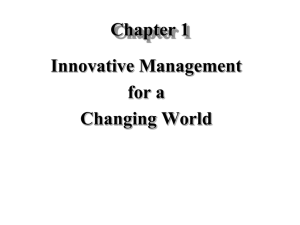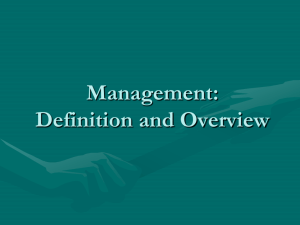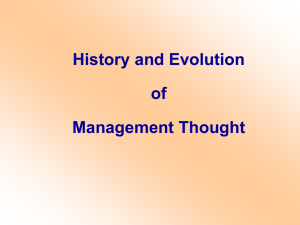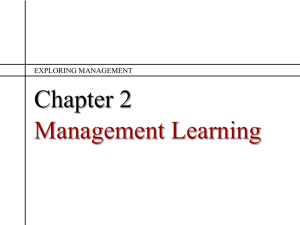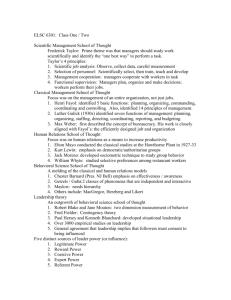Organisational Behavior
advertisement
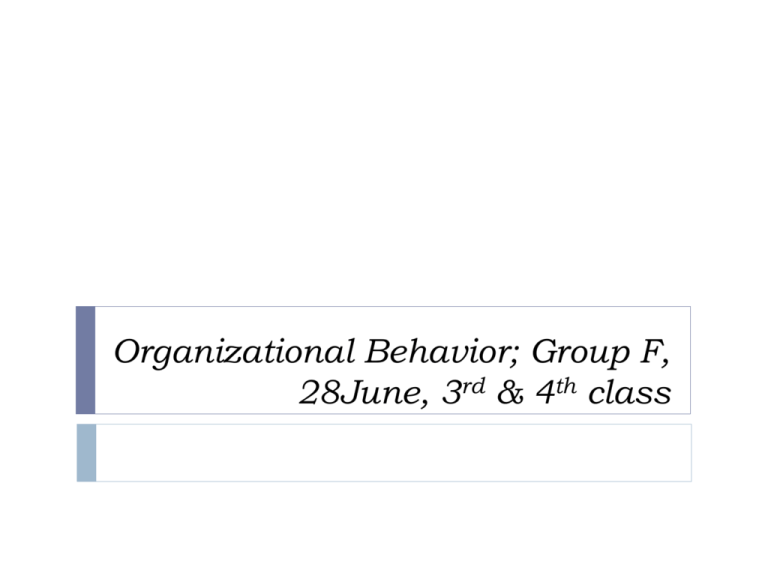
Organizational Behavior; Group F, 28June, 3rd & 4th class Coverage Summing up from last session Why OB What is an Organization Challenges for today’s organization How excellent organizations are responding; What is Organization Behavior Manager. Leading.. Questions.. What are 4 managerial activities. How do Managers allocate their time in these 4 managerial activities. What Managers do. What are different approaches to management. What is classical, behavioral & quantitative approach to management. Who are exponent of these approaches. What is Howthrone studies. What is an Organization Exist for a purpose or goal What all go in to achieving the goal? 7 S model Manager & Leader make it happen(we will discuss little later) Questions; Challenges & Issues for today’s organization Competition. Survival of fittest. How to win over customer who have options. Future is not secured just because you are best today. Need to improve, innovate & adapt.. Internal – coping with employee expectations, diverse workforce, Means are important – How excellent organization are responding Strategy – out side in, clear communication to align every body, hedgehog concept, Structure Execution Performance culture. GE example- normal curve & performance-values Leadership Talent development Innovation. Growth. What is Organization Behavior Study of Behavior of individuals & groups. Why they behave in the manner that they do & what impact their behavior. What impact or influence their behavior. Ref; my note book Why individuals & people behave the manner they do Hitler & Nazi killed thousands of Jews. Why workmen go on strike even if most of their needs taken care. How can otherwise timid & peaceful person become part of violent mob Why individuals & people behave the manner they do A non performer in one dep't/organization become outstanding performer in another dep't/organization How somebody who is a mediocre in one role/job, excel in another role/job How a Sales/Finance Manager not fitting in to sales profile excel contrary to perception & vice versa Why individuals & people behave the manner they do Why an individual take extreme step which is quite unexpected. Examples Do different nationals have certain defined behavior pattern. If yes, why is it so. Example- Indians are not good team player Why a customer prefer not to go some body who is offering the best value for money. Why individuals & people behave the manner they do Why financial institutions & investor at times bet with seemingly wrong horse or with specific horses. Why employees or workmen not necessarily follow the technically most brilliant Manager in the company. What make soldiers embrace death. Why individuals & people behave the manner they do Why a terrorist unrepentant of killing innocent people. Why millions of people either ready to undergo sacrifice for a cause When an employee give his best in an organizational context. Why some employees or people can not make that extra effort in spite of manager’s best efforts to motivate them. What I can learn as an individual & future manager? I am specializing in finance, how can OB be useful to me? The Manager All important role of Manager in achieving organizational goals What a Manager does to achieve goals (P,O,C, L); Lagan Part 1 What skill he needs to have? Tech.. Will the skill level vary at different levels? Leading…. Barak Obama & leadership skill.Video Film & discussion Next class Individual Behavior Definition of Learning Theoritical process of learning Application of learniing theories modification. for behavioral Management Defined Process of working with and through individuals & groups and other resources (equipment, capital & technology) to accomplish organisational goals………… Hersey & Blanchard, pp9 Attainment of organisational goals in an effective & efficient manner through planning, organsing, leading & controlling organisational resources………Aswathappa Management as a Discipline Classifying management as a discipline suggests that there is a body of knowledge that can be learned. (1) Management is a subject with principles, concepts, and theories. (2) A critical purpose of studying management is to learn how in the process of managing to apply principles, concepts, and theories of management. Organisation Group Individual Physiology Economics Semantics OB Anthropology Political Science Sociology Psychology Social & Industrial Psychology Social Psychology Sociology Learning Motivation Personality Emotions Job Satisfaction Individual Attitude Change Communication Group Processes Conflict Power Intergroup Behavior Group Org Theory Org Culture Org Change Anthropology Comparative Values / Attitudes Cross-cultural Analysis Org. Culture Org Environment] Organisatio nal System O B What Managers Do Plan Control Organise Managers Coordinate Command 4 managerial activities Traditional management: Decision making, planning, controlling, etc. Communication: Exchanging routine info. Processing paperwork, etc. Human Resources Management: Motivating, disciplining staff, managing conflict, training, staffing, etc. Networking: Socializing, politicking, interacting with outsiders, etc. Source: Robbins, pg 8 What Managers Do Planning Controlling Managers Leading Organising Process of Management The management process is an integrated whole even though we may describe the process as a series of separate activities to understand the parts. The model we are using identifies the management functions as planning, organizing, and controlling linked together by leading. What does this mean? Planning determines what results the organization will achieve, organizing specifies how it will achieve the results, and controlling determines whether results are achieved and by using planning, organizing and controlling managers exercise leadership. Planning The organizing, leading, and controlling functions all come from planning. How? These functions carry out the planning decisions. These plans may differ in focus from goals for the short or long term but as a whole these plans are the primary tools for preparing for and dealing with changes in the organization’s environment. Organizing The purpose of the organizing function is to create a structure of task and authority relationships to achieve the organization’s objectives. Organizing can be viewed as turning plans into action and this allows an organization to function effectively as a cohesive whole. Controlling The controlling function of management requires 3 elements: 1. Established standards of performance. 2. Information that indicates deviations between actual performance and the established standards. 3. Action to correct performance that does not meet these standards. Leading Leading is the management process that integrates everything else a manger does. Leadership is a difficult concept to define but means the ability to influence others to pursue a common goal. Think about good leaders that you have known. Good leaders are typically driven by an overriding vision or mission. Roles & Functions Interpersonal • Figurehead • Leader • Liaison Informational • Monitor • Disseminator • Spokesperson Decisional • • • • Entrepreneur Disturbance Handler Resource Allocator Negotiator Source: Adapted from "The Nature of Managerial Work" - H. Mintzberg , (Robbins, pg 6) Management Affects Everyone Peter Drucker, a nationally recognized management consultant describes 3 major tasks of managers as: 1. To decide the purpose and mission of the organization. 2. To make work productive. 3. To manage social impacts and responsibilities. APPROACHES TO MANAGEMENT Classical Behavioral Quantitative OPERATIONAL APPROACH •Management is a process. •Universalist/ Classist/ Traditional Approach. •This school concentrates on the role and functions of managers and distills the principles to be followed by them. •Features –Functions of managers remain same –Functions of management –Core of good management –Framework of management –Principles of management •Contributors –Fayol, Lyndall Urwick, Harold Koontz, Newman, Mc Farland, Taylor. •Uses –Flexible & practical but not universal. The Classical Approach The serious study of management began in the late 19th century with the need to increase the efficiency and productivity of the workforce. The classical approach to management can be understood by looking at 2 perspectives: 1. Scientific management concentrated on the problems of lower-level managers 2. Classical organizational theory focused on problems of top-level managers. The Classical Approach (Cont.) Think about the context. At the turn of the 20th century, business was expanding and creating new products and new markets, but labor was in short supply. The solutions were (1) substitute capital for labor or (2) use labor more efficiently. Classical Organizational Theory Another body of ideas developed at the same time. While scientific management focused on the management of work, the Classical approach focused on the management of organizations. The classical organizational theory focus was on (1) developing principles that could guide the design, creation, and maintenance of large organizations and (2) to identify the basic functions of managing organizations. Engineers were the main contributors to scientific management while practicing executives were the major contributors to classical organizational theory. Human labour becomes alienated labour, an idea first put forward by Marx. He set out a number of dimensions of alienation, describing the impact of class relations on work and on the wider human community. 1. Workers are divorced from the product of their labour and from the process of production 2. The fact that labour is ‘external’ to the worker, a mere means to an end follows from this 3. These economic factors have social consequences in the people become alienated from themselves. 4. A broader social alienation occurs - people stand in an instrumental relationship to one another The Contributors to Classical Organizational Theory: Weber and Fayol Max Weber was the primary architect of the theory of the organization as a bureaucracy. His view of a bureaucracy was a smoothly functioning, highly efficient machine in which each part is tuned to perform its prescribed function. Weber and Rationalization (1800s) Thoughts on “personal” family like organisations Employees loyal to indivual supervisors rather than organisations Rational Behaviour - Central dynamic of western capitalist societies Spirit of Rationality Rationality here refers to the use of formal procedures (capital accounting, systematic management, corporate planning, etc) Formal & Substantive Rationality Formal rationality refers to the calculation of economic means Substantive rationality refers to the persistent intervention of human ends and values The two rationales were ‘always in principle in conflict’, since human needs are not necessarily met by rational calculation Max Weber (Cont.) Weber believed that an efficient organization should be based on 5 principles Principle 1. In a bureaucracy, a manager’s formal authority comes from the position held in the organization. Principle 2. In this context people should occupy positions because of their performance, not because of their social standing or personal contacts. Principle 3. The extent of each position’s formal authority and task responsibilities should be clearly understood. Principle 4. Positions should be arranged hierarchically to that authority is exercised effectively and employees know to whom they are to report and who reports to them. Principle 5. Managers must create a will-defined systems of rules, standard operating procedures, and norms to control behavior within an organization. Webers’ Bureaucracy Weber believed that all bureaucracies have the following characteristics: A well-defined hierarchy All positions within a bureaucracy are structured in a way that permits the higher positions to supervise and control the lower positions. This clear chain of command facilitates control and order throughout the organization. Division of labor and specialization All responsibilities in an organization are specialized so that each employee has the necessary expertise to do a particular task. Rules and regulations Standard operating procedures govern all organizational activities to provide certainty and facilitate coordination. Impersonal relationships between managers and employees Managers should maintain an impersonal relationship with employees so that favoritism and personal prejudice do not influence decisions. Competence Competence, not “who you know,” should be the basis for all decisions made in hiring, job assignments, and promotions in order to foster ability and merit as the primary characteristics of a bureaucratic organization. Records A bureaucracy needs to maintain complete files regarding all its activities. Henri Fayol Division of work: Division of work and specialization produces more and better work with the same effort. Authority and responsibility: Authority is the right to give orders and the power to exact obedience. A manager has official authority because of her position, as well as personal authority based on individual personality, intelligence, and experience. Authority creates responsibility. Discipline: Obedience and respect within an organization are absolutely essential. Good discipline requires managers to apply sanctions whenever violations become apparent. Unity of command: An employee should receive orders from only one superior. Unity of direction: Organizational activities must have one central authority and one plan of action. Subordination of individual interest to general interest: The interests of one employee or group of employees are subordinate to the interests and goals of the organization. Remuneration of personnel: Salaries — the price of services rendered by employees — should be fair and provide satisfaction both to the employee and employer. Centralization: The objective of centralization is the best utilization of personnel. The degree of centralization varies according to the dynamics of each organization. Scalar chain: A chain of authority exists from the highest organizational authority to the lowest ranks. Order: Organizational order for materials and personnel is essential. The right materials and the right employees are necessary for each organizational function and activity. Equity: In organizations, equity is a combination of kindliness and justice. Both equity and equality of treatment should be considered when dealing with employees. Stability of tenure of personnel: To attain the maximum productivity of personnel, a stable work force is needed. Initiative: Thinking out a plan and ensuring its success is an extremely strong motivator. Zeal, energy, and initiative are desired at all levels of the organizational ladder. Esprit de corps: Teamwork is fundamentally important to an organization. Work teams and extensive face-to-face verbal communication encourages teamwork. Modern management and Taylorism 19th C Capitalism The Principles of Scientific Management – 1911 Scientific management methods called for optimizing the way that tasks were performed and simplifying the jobs enough so that workers could be trained to perform their specialized sequence of motions in the one "best" way. Time & Motion Studies - Use of a stopwatch to time a worker's sequence of motions, with the goal of determining the one best way to perform a job. The Classical Approach (Cont.) Frederick W. Taylor made an important contribution to scientific management. He observed workers producing far less than capacity in steel firms. He recognized their were no studies to determine expected daily output per worker in the form of work standards and the relationship between these standards and wages. Then he tried to find the one best way to do a job, determining the optimum work pace, the training of people to do the job properly and successful rewards for performance but using an incentive pay system. The Classical Approach Taylor’s work lead to the following 4 principles: Principle 1. Study the way workers perform their tasks, gather all the informal knowledge that workers possess, and experiment with ways to improves the performance of tasks. Principle 2. Codify the new methods of performing tasks into written rules and standard operating procedures (sops). Principle 3. Carefully select workers so that they possess skills and abilities that match the needs of the task and train them to perform according to rules and procedures. Principle 4. Establish a fair or acceptable level of performance for a task and then develop a pay system that awards acceptable performance. Taylor's 4 Principles of Scientific Management Replace rule-of-thumb work methods with methods based on a scientific study of the tasks. Scientifically select, train, and develop each worker rather than passively leaving them to train themselves. Cooperate with the workers to ensure that the scientifically developed methods are being followed. Divide work nearly equally between managers and workers, so that the managers apply scientific management principles to planning the work and the workers actually perform the tasks. Used by Henry Ford in automobile industry Contributions of the Classical Approach The greatest contribution of the classical approach was the identification of management as an important element of organized society. The identification of management functions: planning, organizing and controlling provided the basis for training new managers and was a valuable practice. Many management techniques used today: time and motion analysis, work simplification, incentive wage systems, production scheduling, personnel testing, and budgeting are techniques from the classical approach. Limitations of the Classical Approach One major criticism is that the majority of insights are to simplistic for today’s complex organization. The classical approach and the scientific management approach worked in organizations that were very stable and predictable and today little of that exists. Behavioral Approach The behavioral approach to management has 2 branches: the Human relations approach from the 1950’s and the behavioral science approach. In the human relations approach managers must know why their subordinated behave as they do and what psychological and social factors influence them. Advocates of this approach try to show how the process and functions of management are affected by differences in individual behavior and the influence of groups in the workplace. This approach requires managers to recognize employees’ need for recognition and social acceptance and this results in training in human relation skills for managers. The Behavioral Science Approach The individuals in the behavioral science branch of the behavioral approach believe that the human is more complex than the “economic man” description of the classical approach and the “social man” description of the human relations approach. The behavioral science approach concentrates more on the nature of work itself and the degree to which it can fulfill the human need to use skills and abilities. Behavioral Management The behavioral management theory is often called the human relations / behavioral science approach because it addresses the human dimension of work. Behavioral theorists believed that a better understanding of human behavior at work, such as motivation, conflict, expectations, and group dynamics, improved productivity. Psychological & Social factors that influence them. The theorists who contributed to this school viewed employees as individuals, resources, and assets to be developed and worked with — not as machines. HUMAN BEHAVIOUR APPROACH •Organisation as people –a) Interpersonal Behavior Approach -Individual Psychology –b) Group Behaviour Approach -Organisation Behavior •Features –Draws heavily from psychology & sociology. –Understand human relations. –Emphasis on greater productivity through motivation & good human relations –Motivation, leadership, participative management & group dynamics are core of this approach. HUMAN BEHAVIOUR APPROACH •Uses –Demonstrates how management can be effective by applying knowledge of organisation behaviour. •Contributors –Maslow, Herzberg, Vroom, McCleland, Argyris, Likert, Lewin, Mc Gregor, etc. •Limitations –Treating management as equivalent to human behaviour. –Talks about organisation & organisation behaviour in vague terms. Contributions of Behavioral Approach Contributions of the Behavioral Approach include increased use of teams to accomplish organizational goals, focus on training and development of employees, and the use of innovative reward and incentive systems. In addition the focus on modern management theory resulted in empowering employees through shared information. The Behavioral Science Approach The Hawthorne Studies: a series of research studies conducted at the Hawthorne Works of General Electric helped lend support to the behavioral approach to management theory. The research used varying lighting levels in the plant’s secretarial pool to determine the effects of different levels on productivity expecting productivity levels to drop when lighting levels dropped. The Result was surprising: productivity only dropped when workers could no longer see well enough to do their work. The results showed that the presence of the researchers was affecting the results because the workers enjoyed the attention and produced the results they believed the researchers wanted. Summary: The Hawthorne effect was used to describe this effect of increased productivity due to increased attention. Hawthorne Effect The general conclusion from the Hawthorne studies was that human relations and the social needs of workers are crucial aspects of business management. This principle of human motivation helped revolutionize theories and practices of management Limitations of the Behavioral Approach The limitations included the difficulty for managers in problem situations and the fact that human behavior is complex. This complicated the problem for managers trying to use insights from the behavioral sciences which often changed when different behavioral scientists provided different solutions. The Management Science Approach The Management Science approach is a modern version of the early emphasis on the “management of work” in scientific management. It features the use of mathematics and statistics to aid in resolving production and operations problems, thus focusing on solving technical rather than human behavior problems. The management science approach was used in World War II when the English formed teams of scientists, mathematicians, and physicist into units called operations research teams, and today businesses use these teams to deal with operating issues. Quantitative Approach Resulted from research during WW II The quantitative approach to management involves the use of quantitative techniques, such as statistics, information models, and computer simulations, to improve decision making Operations Management - Focuses on managing the process of transforming materials, labor, and capital into useful goods and/or services MIS - Organizes past, present, and projected data from both internal and external sources and processes it into usable information, which it then makes available to managers at all organizational levels Contributions of the Management Science Approach Most important contributions are in production management focusing on manufacturing production and the flow of material in a plant and in operations management solving production scheduling problems, budgeting problems and maintenance of optimal inventory levels. Limitations of the Management Science Approach The shortfall of this approach is that management science does not deal with the people aspect of an organization. Attempts to Integrate the Three Approaches to Management One attempt to integrating the three approaches to management is the Systems Approach. The Systems Approach stresses that organizations must be viewed as systems in which each part is linked to each other. The other approach is the Contingency Approach. The Contingency Approach stresses that the correctness of a managerial practice is contingent on how it fits the particular situation. The system’s approach views the elements of an organization as interconnected and as being linked to its environment. Attempts to Integrate the Three Approaches to Management It is important to understand that most organizations must operate as open systems to survive and use a systems perspective to management. And the objectives of the individual parts of the organization must be compromised for the objectives of the entire firm. Attempts to Integrate the Three Approaches to Management The contingency theorists believe that most workplace situations are too complex to analyze and control as the scientific management approach suggests. Paul Hersey has developed a situationalist theory of leadership. He believes managers should not ascribe to one best approach. Instead managers should identify the appropriate principles, along with relevant contingency variables and then evaluate these factors. In summary, the contingency approach involves identifying the important variables in different situations, evaluating the variables, and then applying appropriate management knowledge and principles in selecting an effective approach to the situation. And Now To The Fun! Learning How to Manage The MBA program will help you develop your knowledge, attitudes and skills. And it will teach you how to apply your formal education so that once you become a manager you will understand how to face challenges and make decisions. The term management refers to the body of knowledge, concepts and procedures used by managers. A great deal of management knowledge comes from the autobiographies of people who practiced management. EMPIRICAL APPROACH •Study of managerial experiences and cases (mgt) •Features –Study of Managerial Experiences –Managerial experience passed from practitioner to students for continuity in knowledge management. –Study of Successful & failure cases help practising managers. –Theoretical research combined with practical experiences. •Uses –Learning through experience of others •Limitations –No Contribution for the development of management as a discipline –Situations of past not the same as present.



